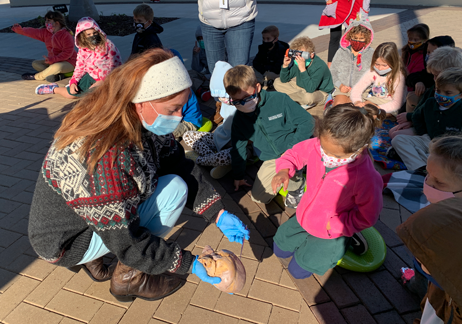

First Graders Have a Heart
Source/Author: Raffi Darrow, Ebytes Editor
December 10, 2020
Mrs. Lisa Peck, Director of Shorecrest Upper School’s Center for Medical Sciences, is a favorite first grade guest expert during their in-depth investigation of the human body.
From her first visit with a real human skeleton, to her dissection of cow’s eyes with the students, she shares in-depth, hands on science training with young Chargers.
In November, first graders "pumped up" their love of learning with lessons about the circulatory system. The children learned how the heart pumps blood all around their bodies, carrying precious life-giving nutrients and oxygen throughout, and carrying carbon dioxide back to the lungs to be dispelled into the air.
They learned about different ways to keep their hearts healthy and strong. Eating healthy foods, exercising, and making heart-smart decisions can keep your ticker ticking right along. Through experiments, books, videos, and discussions, the little scientists learned so much every day!
Part of their experiential learning was playing Heart-Beat the Clock. A heart pumps 1.3 gallons of blood through a body per minute. A little over a gallon per minute means that with each heartbeat about ¼ cup is pumped. As a relatable illustration of this, teachers poured a gallon of water into a red container (representing a heart.) Then, with a timer set for one minute, children transferred water from the “heart” container to another container using a 1/4 measuring cup, thus simulating the pumping of blood through the body and just how hard our hearts work.
In early December, Mrs. Peck returned from Upper School and brought a plastic model of a heart to point out the different chambers, veins, arteries and heartstrings. She also dissected a sheep’s heart and showed the first graders the atria, ventricles, coronary arteries, the aorta, valves and heartstrings. Mrs. Peck dissected a heart for each class to take back to their classroom to observe its anatomy. Watch for a video on our Instagram account soon!
First grade will continue to enthusiastically explore and investigate questions and wonderings about the human body.
From her first visit with a real human skeleton, to her dissection of cow’s eyes with the students, she shares in-depth, hands on science training with young Chargers.
In November, first graders "pumped up" their love of learning with lessons about the circulatory system. The children learned how the heart pumps blood all around their bodies, carrying precious life-giving nutrients and oxygen throughout, and carrying carbon dioxide back to the lungs to be dispelled into the air.
They learned about different ways to keep their hearts healthy and strong. Eating healthy foods, exercising, and making heart-smart decisions can keep your ticker ticking right along. Through experiments, books, videos, and discussions, the little scientists learned so much every day!
Part of their experiential learning was playing Heart-Beat the Clock. A heart pumps 1.3 gallons of blood through a body per minute. A little over a gallon per minute means that with each heartbeat about ¼ cup is pumped. As a relatable illustration of this, teachers poured a gallon of water into a red container (representing a heart.) Then, with a timer set for one minute, children transferred water from the “heart” container to another container using a 1/4 measuring cup, thus simulating the pumping of blood through the body and just how hard our hearts work.
In early December, Mrs. Peck returned from Upper School and brought a plastic model of a heart to point out the different chambers, veins, arteries and heartstrings. She also dissected a sheep’s heart and showed the first graders the atria, ventricles, coronary arteries, the aorta, valves and heartstrings. Mrs. Peck dissected a heart for each class to take back to their classroom to observe its anatomy. Watch for a video on our Instagram account soon!
First grade will continue to enthusiastically explore and investigate questions and wonderings about the human body.
























